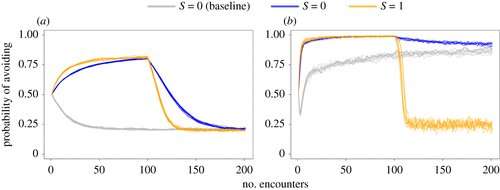March 16, 2022 report
Modeling human-animal interactions to show when animals should avoid humans

A team of researchers from the University of Exeter and the Max Planck Institute for Evolutionary Anthropology has built a model to show where human-animal interactions are in the best interests of the animals. In their paper published in the journal Royal Society Open Science, the group describes the factors they used to create their model.
Anecdotal evidence suggests that animals have a difficult time figuring out which humans to trust and which to avoid. Some humans, for example, may extend a hand filled with food, while others may pull out a gun and start shooting. Because of that, animals have taken different approaches to dealing with humans. In this new effort, the researchers have built a model to assess the danger level for different kinds of animals encountering people in different kinds of scenarios.
The model was based on computer algorithms that assess risk factors based on various scenarios—deer foraging in urban areas, for example, are much less likely to be shot than deer foraging in rural areas. Bears, on the other hand, are more likely to be shot in urban areas. The researchers also factored in variables to rate the degree to which animals can distinguish good or safe individual people from those that are likely to harm them. Pigeons at a park in a city, for example, learn to identify regular visitors who feed them, while avoiding those who do not. The researchers also added the ability to rate direct learning by animals versus social learning. Birds, for example, tend to grow up learning to avoid domestic cats—they learn such skills from other birds, or even other animals. They also learn directly, when searching for worms in a yard where children might try to catch them, for example.
The model showed that animals that learn about human behavior quickly tend to do best in places where humans tend to act the same, whether friendly or with malice. And that can be helpful—deer moving into safe urban areas to escape hunting out in the country, for example. But it also showed that fast learning can have its drawbacks—deer learning to trust humans in general can lead them to be less than careful in hunting scenarios. The model also showed mixed results when animals learned to trust individual people. In some cases, it can be beneficial, such as when they get fed. But it can also lead to a lot of time spent learning about human behavior that could be used to find food for themselves.
More information: Madeleine Goumas et al, Predator or provider? How wild animals respond to mixed messages from humans, Royal Society Open Science (2022). DOI: 10.1098/rsos.211742
Journal information: Royal Society Open Science
© 2022 Science X Network



















